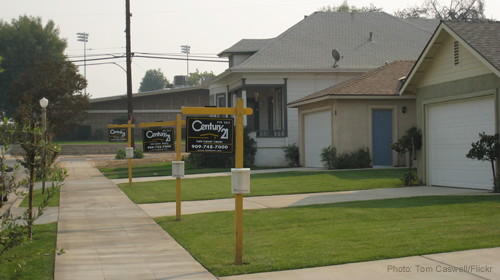
The housing price tide may be rising, but it's failing to lift up many in our communities of color.
That's because lots of homeowners in these communities are underwater, meaning they purchased homes during the real estate bubble and now owe more on their mortgages than their homes are worth. As a result, they're not building equity in their homes, and they're likelier to end up in foreclosure.
A new from UC-Berkeley's Haas Institute reveals the depth of the problem. Nearly 10 million American households remain underwater. These households are disproportionately concentrated in African-American and Latino communities, in part because these communities were the primary targets of lenders peddling predatory loans during the housing boom. These were the loans issued to fuel Wall Street's securitization machine.
As a result, in the five cities with the highest rates of homes underwater, at least 80 percent of residents are African-American or Latino. In two-thirds of the 395 zip codes with the highest rates of homes underwater, at last half of residents are African-American or Latino.
So what's a local government in a struggling community to do? Sit back while underwater mortgages lead to foreclosures, which then cause a in the value of neighbors' homes? Watch while houses are boarded up and eat the of maintaining safety and security for those houses? Stand by while blight develops as a result of foreclosures?
Some hard-hit towns and cities around the country like , California, and Newark, New Jersey, are considering taking action instead.
They're proposing using their eminent domain powers to seize the most toxic underwater mortgages. These are mortgages that have been sold to Wall Street and are now stuck, so that mortgage servicers can't modify them even when it would be in everyone's best interest to do that. The municipality would then issue new mortgages to the existing homeowners with a reduced principal amount, lowering monthly mortgage payments and allowing families to stay in their homes. Happily, preventing foreclosures also saves the municipalities money.
But the financial industry has come out with guns blazing against these proposals. It filed not one, but two separate against Richmond when it took its first step toward enacting an eminent domain plan, both of which were tossed out of court.
And the industry has to get the federal government to block eminent domain efforts.
We're litigating a Freedom of Information Act case right now to find out just how hard. The documents that the government has released so far show that the financial industry has been in constant communication with the Federal Housing Finance Agency, urging officials to put a stop to local communities' principal reduction efforts. And it worked, too. Last summer, the FHFA issued a threatening to sue or take other aggressive action against communities that use eminent domain for this purpose.
Since that time, the FHFA's leadership has changed. We're hopeful that its new chief, Mel Watt, will , recognizing the importance of principal reduction both for our national economy and for struggling towns and cities.
After being targeted by predatory lenders, saddled with unfair mortgages, and bypassed by the housing recovery they've heard so much about, underwater homeowners in communities of color deserve at least this much from the federal government. If towns and cities can fix these mortgages, legally, using eminent domain, why would the government stand in the way?
Instead, the FHFA should do its part to ensure that the recovery reaches all of our communities, especially the ones hardest hit by Wall Street's irresponsibility.
Learn more about predatory lending and other civil liberty issues: Sign up for breaking news alerts, , and .

